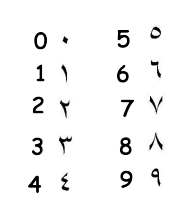Children recruit higher-order brain mechanisms during a numerical comparison task
I've been endlessly scoring digit-symbol coding protocols (fun...), a subtest of the WAIS-IV measuring working memory, for the past few weeks at my new neuropsych externship so the following article seems particularly relevant.
In a recent study by Cantlon and colleagues published in the latest Journal of Cognitive Neuroscience, they decided to measure the brain activity of 6-7 year-old children during numerical comparison tasks using fMRI.
An example of a numerical comparsion task:
The authors found that 6- and 7-year-old children recruit the occipito-temporal and parietal cortex in order to solve numerical comparisons across different notation systems, similar to that of adults. However, (here's the kicker) the fMRI showed that children also activate the inferior frontal cortex to a much greater degree than adults during these numerical comparison tasks. This particular area of the brain involves Brodmann area 44 and 45, used for retrieving semantic information when strong stimulus-stimulus associations are absent.
Interestingly enough, the inferior frontal cortex has also been shown to play a role in music cognition (Levitin, 2009). Could kindergarten be the optimal time to learn how to play an instrument?
The current study provides further evidence that "a core neural system integrates notation-independent numerical representations throughout development but, early in development, higher-order brain mechanisms mediate this process".
Song JH, & Nakayama K (2008). Numeric comparison in a visually-guided manual reaching task. Cognition, 106 (2), 994-1003 PMID: 17512516
Levitin, D. (2009). The Neural Correlates of Temporal Structure in Music Music and Medicine, 1 (1), 9-13 DOI: 10.1177/1943862109338604
Cantlon, J., Libertus, M., Pinel, P., Dehaene, S., Brannon, E., & Pelphrey, K. (2009). The Neural Development of an Abstract Concept of Number Journal of Cognitive Neuroscience, 21 (11), 2217-2229 DOI: 10.1162/jocn.2008.21159
In a recent study by Cantlon and colleagues published in the latest Journal of Cognitive Neuroscience, they decided to measure the brain activity of 6-7 year-old children during numerical comparison tasks using fMRI.
An example of a numerical comparsion task:
...participants were required to compare a single digit Arabic number presented on the center square with the standard, 5. Participants were asked to reach and touch one of three squares on the screen with their index finger while their hand movement trajectories were recorded: the left square for 1–4, the center for 5, and the right for 6–9 (Song & Nakayama, 2007).
The authors found that 6- and 7-year-old children recruit the occipito-temporal and parietal cortex in order to solve numerical comparisons across different notation systems, similar to that of adults. However, (here's the kicker) the fMRI showed that children also activate the inferior frontal cortex to a much greater degree than adults during these numerical comparison tasks. This particular area of the brain involves Brodmann area 44 and 45, used for retrieving semantic information when strong stimulus-stimulus associations are absent.
Interestingly enough, the inferior frontal cortex has also been shown to play a role in music cognition (Levitin, 2009). Could kindergarten be the optimal time to learn how to play an instrument?
The current study provides further evidence that "a core neural system integrates notation-independent numerical representations throughout development but, early in development, higher-order brain mechanisms mediate this process".
Song JH, & Nakayama K (2008). Numeric comparison in a visually-guided manual reaching task. Cognition, 106 (2), 994-1003 PMID: 17512516
Levitin, D. (2009). The Neural Correlates of Temporal Structure in Music Music and Medicine, 1 (1), 9-13 DOI: 10.1177/1943862109338604
Cantlon, J., Libertus, M., Pinel, P., Dehaene, S., Brannon, E., & Pelphrey, K. (2009). The Neural Development of an Abstract Concept of Number Journal of Cognitive Neuroscience, 21 (11), 2217-2229 DOI: 10.1162/jocn.2008.21159
